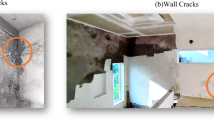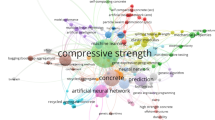Abstract
This paper studies the ability of artificial neural network (ANN), adaptive neuro fuzzy inference system (ANFIS), multivariate adaptive regression splines (MARS) and M5 Model Tree (M5Tree) techniques to predict ultimate conditions of fiber-reinforced polymer (FRP)-confined concrete. A large experimental test database that consists of over 1000 axial compression tests results of FRP-confined concrete specimens assembled from the published literature was used to train, test, and validate the models. The modeling results show that the ANN, ANFIS, MARS and M5Tree models fit well with the experimental test data. The M5Tree model performs better than the remaining models in predicting the hoop strain reduction factor and strength enhancement ratio, whereas the ANN model provided the most accurate estimates of the strain enhancement ratio. Performances of the proposed models are also compared with those of the existing conventional and evolutionary algorithm models, which indicate that the proposed ANN, ANFIS, MARS and M5Tree models exhibit improved accuracy over the existing models. The predictions of each proposed model are subsequently used to establish the interdependence of critical parameters and their influence on the behavior of FRP-confined concrete, which are discussed in the paper.








Similar content being viewed by others
References
Ozbakkaloglu T, Lim JC, Vincent T (2013) FRP-confined concrete in circular sections: review and assessment of stress–strain models. Eng Struct 49:1068–1088
Richart FE, Brandtzaeg A, Brown RL (1928) A study of the failure of concrete under combined compressive stresses. Bulletin No. 185. Engineering Experimental Station. University of Illinois, Champaign
Cevik A, Cabalar AF (2008) A genetic-programming-based formulation for the strength enhancement of fiber-reinforced-polymer-confined concrete cylinders. J Appl Polym Sci 110(5):3087–3095
Cevik A, Guzelbey IH (2008) Neural network modeling of strength enhancement for CFRP confined concrete cylinders. Build Environ 43(5):751–763
Cevik A, Gogus MT, Guzelbey IH, Filiz H (2010) Soft computing based formulation for strength enhancement of CFRP confined concrete cylinders. Adv Eng Softw 41(4):527–536
Naderpour H, Kheyroddin A, Amiri GG (2010) Prediction of FRP-confined compressive strength of concrete using artificial neural networks. Compos Struct 92(12):2817–2829
Cevik A (2011) Modeling strength enhancement of FRP confined concrete cylinders using soft computing. Expert Syst Appl 38(5):5662–5673
Elsanadedy HM, Al-Salloum YA, Abbas H, Alsayed SH (2012) Prediction of strength parameters of FRP-confined concrete. Compos B 43(2):228–239
Jalal M, Ramezanianpour AA (2012) Strength enhancement modeling of concrete cylinders confined with CFRP composites using artificial neural networks. Compos B 43(8):2990–3000
Ozbakkaloglu T, Lim JC (2013) Axial compressive behavior of FRP-confined concrete: experimental test database and a new design-oriented model. Compos B 55:607–634
Lim JC, Ozbakkaloglu T (2014) Confinement model for FRP-confined high-strength concrete. J Compos Constr ASCE 18(4):04013058
Lee S, Lee C (2014) Prediction of shear strength of FRP-reinforced concrete flexural members without stirrups using artificial neural networks. Eng Struct 61:99–112
Sobhani J, Najimi M, Pourkhorshidi AR, Parhizkar T (2010) Prediction of the compressive strength of no-slump concrete: a comparative study of regression, neural network and ANFIS models. Constr Build Mater 24(5):709–718
Güneyisi EM, Mermerdaş K, Güneyisi E, Gesoğlu M (2015) Numerical modeling of time to corrosion induced cover cracking in reinforced concrete using soft-computing based methods. Mater Struct 48(6):1739–1756
Friedman JH (1991) Multivariate adaptive regression splines. Ann Stat 19(1):1–141
Cheng M-Y, Cao M-T (2014) Evolutionary multivariate adaptive regression splines for estimating shear strength in reinforced-concrete deep beams. Eng Appl Artif Intell 28:86–96
Quinlan JR (1992) Learning with continuous classes. Proc AI 92:343–348
Behnood A, Olek J, Glinicki MA (2015) Predicting modulus elasticity of recycled aggregate concrete using M5′ model tree algorithm. Constr Build Mater 94:137–147
Perera R, Ruiz A (2012) Design equations for reinforced concrete members strengthened in shear with external FRP reinforcement formulated in an evolutionary multi-objective framework. Compos B Eng 43(2):488–496
Perera R, Tarazona D, Ruiz A, Martín A (2014) Application of artificial intelligence techniques to predict the performance of RC beams shear strengthened with NSM FRP rods. Formulation of design equations. Compos B Eng 66:162–173
Kisi O (2005) Suspended sediment estimation using neuro-fuzzy and neural network approaches. Hydrol Sci J 50(4):683–696
Haykin SS (2009) Neural networks and learning machines, 3rd edn. Prentice Hall, New Jersey
Jang JSR (1993) ANFIS: adaptive-network-based fuzzy inference system. IEEE Trans Syst Man Cybern 23(3):665–685
Jang JSR, Sun CT (1997) Neuro-fuzzy and soft computing: a computational approach to learning and machine intelligence. Prentice Hall, Upper Saddle River, New Jersey
Craven P, Wahba G (1979) Smoothing noisy data with spline functions. Numer Math 31(4):317–403
Mitchell TM (1997) Machine learning. McGraw Hill, Burr Ridge, p 45
Solomatine DP, Xue Y (2004) M5 model trees and neural networks: application to flood forecasting in the upper reach of the Huai River in China. J Hydrol Eng 9(6):491–501
Pal M, Deswal S (2009) M5 model tree based modelling of reference evapotranspiration. Hydrol Process 23(10):1437–1443
Wang Y, Witten IH (1997) Induction of model trees for predicting continuous classes. In: Proceedings of the poster papers of the european conference on machine learning, 128–137
Lim JC, Ozbakkaloglu T (2014) Influence of silica fume on stress-strain behavior of FRP-confined HSC. Constr Build Mater 63:11–24
Lim JC, Ozbakkaloglu T (2015) Investigation of the influence of application path of confining pressure: tests on actively confined and FRP-confined concretes. J Struct Eng ASCE 141(8):04014203
May RJ, Maier HR, Dandy GC (2010) Data splitting for artificial neural networks using SOM-based stratified sampling. Neural Netw 23:283–294
Cigizoglu HK (2003) Estimation, forecasting and extrapolation of river flows by artificial neural networks. Hydrol Sci J 48(3):349–361
Pessiki S, Harries KA, Kestner JT, Sause R, Ricles JM (2001) Axial behavior of reinforced concrete columns confined with FRP jackets. J Compos Constr 5(4):237–245
Lam L, Teng JG (2004) Ultimate condition of fiber reinforced polymer-confined concrete. J Compos Constr ASCE 8(6):539–548
Lim JC, Ozbakkaloglu T (2015) Hoop strains in FRP-confined concrete columns: experimental observations. Mater Struct 48:2839–2854
Rousakis TC, Karabinis AI, Kiousis PD, Tepfers R (2008) Analytical modelling of plastic behaviour of uniformly FRP confined concrete members. Compos B Eng 39(7):1104–1113
Rousakis TC, Rakitzis TD, Karabinis AI (2012) Design-oriented strength model for FRP-confined concrete members. J Compos Constr 16(6):615–625
Hagan MT, Menhaj MB (1994) Training feedforward networks with the Marquardt algorithm. IEEE Trans Neural Netw 5(6):989–993
Kisi O (2007) Streamflow forecasting using different artificial neural network algorithms. J Hydrol Eng 12(5):532–539
Lam L, Teng JG (2003) Design-oriented stress-strain model for FRP-confined concrete. Constr Build Mater 17(6–7):471–489
Bisby LA, Green MF, Kodur VKR (2005) Modeling the behavior of fiber reinforced polymer-confined concrete columns exposed to fire. J Compos Constr 9(1):15–24
Jiang T, Teng JG (2007) Analysis-oriented stress-strain models for FRP-confined concrete. Eng Struct 29(11):2968–2986
Teng JG, Huang YL, Lam L, Ye LP (2007) Theoretical model for fiber-reinforced polymer-confined concrete. J Compos Constr ASCE 11(2):201–210
Al-Salloum Y, Siddiqui N (2009) Compressive strength prediction model for FRP-confined concrete. In: 9th international symposium on fiber reinforced polymer reinforcement for concrete structures, Sydney
Wu YF, Wang LM (2009) Unified strength model for square and circular concrete columns confined by external jacket. J Struct Eng 135(3):253–261
Wu YF, Zhou YW (2010) Unified strength model based on Hoek-Brown failure criterion for circular and square concrete columns confined by FRP. J Compos Constr 14(2):175–184
Realfonzo R, Napoli A (2011) Concrete confined by FRP systems: confinement efficiency and design strength models. Compos B 42(4):736–755
Wei YY, Wu YF (2012) Unified stress-strain model of concrete for FRP-confined columns. Constr Build Mater 26(1):381–392
Tamuzs V, Tepfers R, Zile E, Ladnova O (2006) Behavior of concrete cylinders confined by a carbon composite—3. Deformability and the ultimate axial strain. Mech Compos Mater 42(4):303–314
Binici B (2005) An analytical model for stress-strain behavior of confined concrete. Eng Struct 27(7):1040–1051
Youssef MN, Feng MQ, Mosallam AS (2007) Stress-strain model for concrete confined by FRP composites. Compos B 38(5–6):614–628
Fahmy MFM, Wu ZS (2010) Evaluating and proposing models of circular concrete columns confined with different FRP composites. Compos B 41(3):199–213
Jiang T, Teng JG (2006) Strengthening of short circular RC columns with FRP jackets: a design proposal. In: 3rd international conference on FRP composites in civil engineering, Miami
Teng JG, Jiang T, Lam L, Luo Y (2009) Refinement of a design-oriented stress-strain model for FRP-confined concrete. J Compos Constr 13(4):269–278
De Lorenzis L, Tepfers R (2003) Comparative study of models on confinement of concrete cylinders with fiber-reinforced polymer composites. J Compos Constr 7(3):219–237
Girgin ZC (2013) Modified johnston failure criterion from rock mechanics to predict the ultimate strength of fiber reinforced polymer (FRP) confined columns. Polymers 6(1):59–75
Author information
Authors and Affiliations
Corresponding author
Rights and permissions
About this article
Cite this article
Mansouri, I., Ozbakkaloglu, T., Kisi, O. et al. Predicting behavior of FRP-confined concrete using neuro fuzzy, neural network, multivariate adaptive regression splines and M5 model tree techniques. Mater Struct 49, 4319–4334 (2016). https://doi.org/10.1617/s11527-015-0790-4
Received:
Accepted:
Published:
Issue Date:
DOI: https://doi.org/10.1617/s11527-015-0790-4




